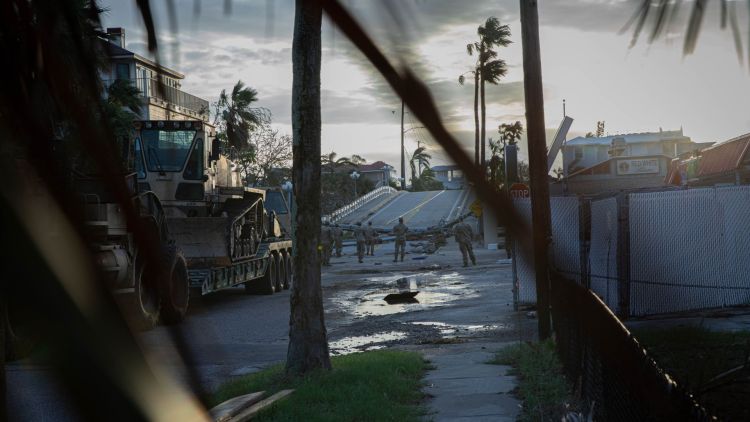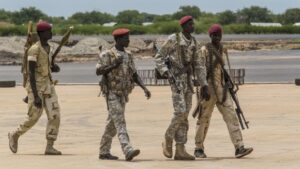In the wake of two powerful storms, Hurricanes Helene and Milton, the US Department of Defense (DoD) and the Federal Emergency Management Agency (FEMA) have sprung into action, mobilizing thousands of personnel, vehicles, and equipment to help those affected. From flooded streets to damaged homes, the devastation in Florida and North Carolina is immense.
But in times like these, the military and emergency services step up, coordinating a massive, all-hands-on-deck recovery and relief effort.
Let’s take a closer look at what’s happening on the ground and how the combined efforts of the DoD, FEMA, and other agencies are making a difference.
Mobilizing for Relief: The Effort in Florida
After Hurricane Milton made landfall in Florida as a Category 3 storm last week, the damage was significant.
In response, the DoD wasted no time, sending over 6,500 National Guardsmen, 26 helicopters, more than 500 high-water vehicles, and a dozen watercraft from 12 different states.
These resources are working to clear debris, repair temporary roofs, and restore waterways to bring some normalcy back to communities.
One of the more immediate tasks involves clearing roads and distributing essential supplies like food and water. While it may sound simple, the logistics of moving people and supplies into a disaster zone are anything but easy.
A Soldier conduct a Survey and Assist patrol following Hurricane Milton in Kissimmee, Florida, October 10, 2024. (US Army/Sgt. Marc Morgenstern)
The Pentagon’s ability to coordinate these efforts across different branches of the military and from multiple states is a testament to the scale and efficiency of the response.
In the wake of two powerful storms, Hurricanes Helene and Milton, the US Department of Defense (DoD) and the Federal Emergency Management Agency (FEMA) have sprung into action, mobilizing thousands of personnel, vehicles, and equipment to help those affected. From flooded streets to damaged homes, the devastation in Florida and North Carolina is immense.
But in times like these, the military and emergency services step up, coordinating a massive, all-hands-on-deck recovery and relief effort.
Let’s take a closer look at what’s happening on the ground and how the combined efforts of the DoD, FEMA, and other agencies are making a difference.
Mobilizing for Relief: The Effort in Florida
After Hurricane Milton made landfall in Florida as a Category 3 storm last week, the damage was significant.
In response, the DoD wasted no time, sending over 6,500 National Guardsmen, 26 helicopters, more than 500 high-water vehicles, and a dozen watercraft from 12 different states.
These resources are working to clear debris, repair temporary roofs, and restore waterways to bring some normalcy back to communities.
One of the more immediate tasks involves clearing roads and distributing essential supplies like food and water. While it may sound simple, the logistics of moving people and supplies into a disaster zone are anything but easy.
A Soldier conduct a Survey and Assist patrol following Hurricane Milton in Kissimmee, Florida, October 10, 2024. (US Army/Sgt. Marc Morgenstern)
The Pentagon’s ability to coordinate these efforts across different branches of the military and from multiple states is a testament to the scale and efficiency of the response.
Beyond the boots on the ground, the safety of military personnel and their families also takes priority.
US Special Operations Command (SOCOM) and US Central Command (CENTCOM), based at MacDill Air Force Base in Tampa, were evacuated before the storm hit to ensure their safety.
Both commands are continuing operations from alternative locations and will return to their home base once it’s safe.
North Carolina: Meeting the Needs After Hurricane Helene
Meanwhile, in North Carolina, relief efforts are just as intense after Hurricane Helene left its mark.
The National Guard has deployed around 5,000 guardsmen, 50 helicopters, and 80 high-water vehicles from 17 different states to help with the recovery. These personnel, along with 1,500 active-duty members, are focused on clearing roads and getting food, water, and other essential commodities to those in need.
One particularly crucial player in the relief efforts is the US Army Corps of Engineers.
With over 550 personnel stationed in 14 emergency operations centers, they’re working on debris control, flood management, and ensuring that waterways remain safe for transport and recovery efforts. Their expertise is vital in getting communities back on their feet, especially when dealing with infrastructure damage.
Leadership and Coordination: The Bigger Picture
While the boots-on-the-ground efforts are impressive, none of this happens without careful coordination at the highest levels.
Secretary of Defense Lloyd J. Austin III, along with other top officials like Deputy Defense Secretary Kathleen Hicks and Vice Chairman of the Joint Chiefs of Staff Admiral Christopher W. Grady, has been receiving daily updates on the relief efforts.
Aerial view of the western coast of Florida, October 10, 2024. (US Army/Sgt. Neysa Huertas Quinones)
It’s not just about military response either—this is a whole-of-government approach.
President Joe Biden, Vice President Kamala Harris, and senior government officials are closely involved, holding regular meetings to assess the situation and ensure that all resources are being deployed effectively.
What’s particularly heartening is how all these different branches of the government, from the White House to FEMA, the DoD, and state and local partners, are working hand-in-hand. It’s a reminder that in times of disaster, the power of coordination and teamwork is invaluable.
The Human Side of the Recovery
While the statistics and numbers are staggering—thousands of personnel, hundreds of vehicles, countless helicopters—the real impact of these efforts is on the people living through the aftermath of these storms.
Imagine being stranded in your flooded home or not knowing where your next meal is coming from. For many in Florida and North Carolina, these aren’t just hypothetical scenarios—they’re living it.
But with the DoD and FEMA’s combined efforts, help is arriving in real-time. Roads are being cleared, supplies are being distributed, and life, slowly but surely, is starting to piece itself back together.
The sight of helicopters flying overhead and National Guardsmen clearing debris might not seem like much, but to those affected, it’s a beacon of hope that things are getting better.
Moving Forward
The road to recovery from Hurricanes Helene and Milton will be long, but the immediate response shows just how committed the DoD and FEMA are to helping Americans in their time of need. As relief efforts continue, more military and emergency personnel are likely to be deployed, and the focus will shift from immediate recovery to long-term rebuilding.
But for now, what matters most is that these affected communities know they aren’t alone. The men and women of the military, alongside FEMA and countless other organizations, are working tirelessly to ensure that everyone has the support they need to recover from these devastating storms. It’s a united front—one that showcases the strength and resilience of the American spirit.
—
Disclaimer: SOFREP utilizes AI for image generation and article research. Occasionally, it’s like handing a chimpanzee the keys to your liquor cabinet. It’s not always perfect and if a mistake is made, we own up to it full stop. In a world where information comes at us in tidal waves, it is an important tool that helps us sift through the brass for live rounds.



